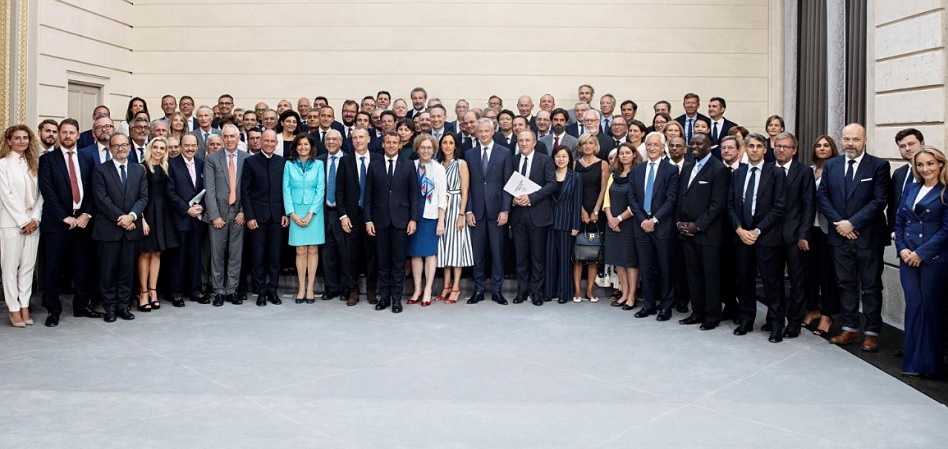Sustainability to the P&L: how fashion gets eco in the heart of its strategy
Although done at a slow pace, the Spanish fashion business incorporates methods to connect sustainability with its performance.

Incentive plans linked to sustainable objectives, council sustainability committees, green bonds, linking debt to sustainability or memories that leave corporate commitments black on white. The global fashion industry has sustainability as one of its strategic pillars. However, it is still only a minority of companies that sophisticate the control mechanisms of their eco goals and which even manage to link sustainability to their profit and loss account.
For years, the marketing and communication departments of fashion businesses used sustainability as an argument. Thus, until recently it was a common practice to communicate, for example, the use of organic cotton or the reduction of consumption of natural resources, but without leaving in writing the objectives set by the company.
“The first thing to do is to identify the aspects related to sustainability to which they want to respond, then establish objectives and, finally, establish indicators that allow us to see if they are moving in the right direction,” reviews Ramón Pueyo, responsible partner of sustainability of KPMG in Spain.
“It is advisable, as established by the rules of good governance, that it is the board of directors itself who oversees that a company has an adequate strategy in terms of sustainability and that the impact on the business is well analyzed,” says the expert.
Identifying the aspects to which to respond, setting objectives and marking KPIs are the keys to a good sustainable roadmap
Gradually, companies begin to become sophisticated. Inditex is one of the most advanced companies. Last June, the Spanish group created a sustainability commission on the board of directors, which will be responsible for monitoring the group’s policies in this regard, in addition to supervising the monitoring of the entire supply chain. The creation of this commission took place shortly before the giant announced its commitments until 2025, which range from the raw materials used by the group to the environmental impact of the stores.
But the measure that most sets sustainability in the group’s strategy is the linking of managers’ remuneration to comply with the so-called sustainability index, although it is still the criterion that scales the least in the overall calculation.
As the company advanced last July, the bonus is subject to the achievement of several objectives: profit growth before taxes (30%), sales growth in comparable stores (30%), total return for the shareholder (30%) and the sustainability index (10%). The remuneration of managers (up to a maximum of 600 executives) will be conditioned by the suppliers, waste, and emissions of the group.
“The fashion sector has been a pioneer in this area, as is the case of Inditex, but it is something that we are seeing more frequently in more sectors,” says Pueyo, who recalls that in the last World Economic Forum in Davos it was requested that the remuneration of managers should be increasingly linked to the impact that companies have on society and its stakeholders.
Inditex has combined the bonus of its managers to comply with the sustainability index
Marcella Wartenbergh, CEO of Pepe Jeans, agrees that the commitment to sustainability must begin at the company’s dome. “Sustainability is something that has to be part of everything we do and starts with the company’s leadership, from the CEO to each person,” says the executive.
However, for now, the company does not have bonuses linked to these KPIs: “I think it is something that we must integrate for the good of the world, for the new generations and for our industry, and not for absurd matters,” says Wartenbergh.

Green debt
Beyond Inditex, only Camper and El Corte Inglés have introduced a sophisticated mechanism to link sustainability with their performance. Last October, Camper formalized sustainable bilateral financing by BBVA, a multinational Spanish bank. “The loan aims to fully support the financing of the working capital of the group in its strategy for the application of the latest technologies in regards to the use of sustainable materials in the process of design and manufacture of footwear lines,” said the company at that time.
Specifically, BBVA formalized in favor of Camper a sustainable revolving line of credit under the Sustainability Linked Loan Principles of the Loan Market Association. The procedure is bilateral financing under the ESG-linked Loan format whose interest rate is connected to the evolution of the company’s sustainability parameters. In this manner, if improvements occur over your initial sustainability assessment, the interest rate of the loan is reduced. For this, the independent sustainability consultant Vigeo Eiris will issue an annual report analyzing the performance of the Spanish group in environmental, social and good governance issues and assigning a rating.
Within the framework of its debt refinancing process, El Corte Inglés has also put sustainability on the table. The cost of the debt could fall if the company meets certain sustainable objectives: the group would have chosen to link the interest rate to be paid with the progress in the field of ESG, which includes the fight against climate change, social responsibility, and governance, according to Expansión. If these objectives are met, the group could see its loan cost reduced by 2.5 basis points; otherwise, the interest rate will increase that same amount.
Camper, Prada, and El Corte Inglés are some of the companies that have linked their debt to sustainable objectives
The Italian luxury group Prada was one of the first in the sector to bet on this mechanism. At
the end of last year, the company announced the signing of a five-year loan worth 50 million euros with Crédit Agricole with interest and clauses linked to sustainability factors. The loan was granted by Crédit Agricole through its corporate banking area Crédit Agricole Corporate and Investment Bank, which also acts as a coordinator and advisor on sustainability.
“This agreement demonstrates that sustainability is a key element for the development of the Prada Group and that every day it is integrated more into our business strategy,” said Alessandra Cozzani, financial director of the Italian group, at the time of signing. “We trust that this collaboration with Crédit Agricole will help us introduce the benefits of corporate responsibility in the financial world,” she added.
From BBVA, they emphasize that these types of credits are common in other sectors, and counting loans for the retail client. “There are specific loans to make reforms or buy hybrid cars; Promotional credits with environmental and other specific bonuses for meat industries or for large groups such as Iberdrola or Gamesa”, they explain from the organization.
“Financial markets are increasingly paying more attention to sustainability, among other reasons, because those more advanced sustainability companies offer a lower level of risk,” says Pueyo.

The association as a commitment
Being part of lobbies are other ways that companies in the sector are finding to carry out their commitment to sustainability. After the Rana Plaza catastrophe, numerous associations focused on the protection of workers’ rights and wages such as ACT (Action, Collaboration, Transformation), which members include Arcadia, Asos, Bestseller, C&A, Primark, Esprit, H&M, Inditex or Zalando, among others.
From an environmental point of view, the largest is the Sustainable Apparel Coalition (SAC) which has more than 200 members, including the Spanish Camper, Hallotex, Inditex and Mango. Another of these lobbies is the Better Coton Initiative, which promotes the use of more sustainable cotton of which 16 Spanish companies take part in such as Textil Santanderina, Tejidos Royo, Inditex, Mango, El Corte Inglés and El Ganso.
Fashion groups have joined forces in organizations such as ACT or SAC and agreements such as Fashion Pact
The most recent pact has been the Fashion Pact, signed last summer in the framework of the G7 summit at the request of the President of France, Emmanuel Macron. This is one of the most important agreements because its signees include fifty of the largest companies in Europe, the United States, and Asia from the sector.
Alongside internationals such as H&M, Kering or Nike are also Inditex, Mango, El Corte Inglés and Tendam. The signatory companies undertake to work within the framework of the Science Based Targets (SBT) initiative, with scientifically measurable objectives. This program is based on three points: stop climate change, restore biodiversity and protect the oceans.
Materials and resources
Outside the framework of these associations, the largest companies in the sector have a defined road map, with specific objectives, in terms of sustainability. Tendam, for example, made its first sustainability report in 2006, audited and following the standards of the Global Reporting Initiative (GRI).
In recent years, the company developed new and more sustainable product lines, and currently, 50% of the denim used by its brands is H2O, 90% less intensive in the use of water in its manufacturing processes. By 2030, Tendam has set the goal for sustainable collections to account for more than 50%.
In addition, the company has signed a contract for the acquisition of renewable energy with guarantees of origin for the consumption of all its facilities in Spain and 98% of the commercial area in the country.
Meanwhile, Mango started publishing a sustainability report in 2005. The company has given greater responsibility to this department, and for ten years the area of corporate social responsibility (CSR) has been directly depending on the general management or Directive Committee.
In recent years, the so-called impact funds have grown, taking into account the socio-environmental impact
Desigual last year defined a three-year strategy “with very ambitious objectives and with the intention of accelerating the achievement of objectives”, they explain from the division responsible for the CSR strategy and sustainability of the group.
The company emphasizes that one of the keys is that “all the teams feel involved”, and that is why they are also giving training for circular design, among others.
The company, immersed in a rebranding process, has also introduced more sustainable materials in its production. In the autumn-winter 2020 collection, the share of sustainable fibers amounts to 11% and the goal for the next campaign is to reach 20%.
Sustainability is also one of the five pillars of Pepe Jeans’ strategy. The group’s corporate social responsibility (CSR) plan progresses in five axes: the product, people, partners, offices, and stores.
In this respect, Pepe Jeans has set itself the objective that 50% of the fibers of its garments be sustainable in 2025 and that all the energy of its offices be renewable in 2025 and 2030 for its stores. In five years, the company also plans to publish its first list of suppliers.
Tous, for its part, details its sustainability strategy on its website. The company emphasizes that in the rehabilitation of its headquarters, between 2005 and 2007, sustainable parameters were taken into account, and that in its jewelry factory a “comprehensive process of resource recovery and sustainable waste management” is adopted. In addition, its packaging has the FSC certificate and its stores use Led lighting since 2013.
Do investors value it?
These efforts also start to be taken into account when assessing a company. According to KPMG estimates, more than three-quarters of the world’s largest investors already take into account issues related to sustainability when analyzing a company. “All of this is based on the conviction that these factors are tremendously relevant for assessing the long-term health of a company,” says Pueyo.
“Rather than betting on sustainable companies, unsustainable ones are avoided,” states the Spanish city, Bilbao. “Analyzation of the water consumption per garment isn’t measured, but rather barbaric activities, especially in production.”
There are also a few specialized funds in sustainable companies, such as Manor Group, an Ecoalf investor, and the so-called impact funds, which seek a measurable socio-environmental impact, in addition to the financial return.
“It is still in a very incipient phase, it can be taken into account to discard a company, but it will not raise its valuation to be more sustainable,” says another expert advisor who has intermediated numerous operations in the sector.


info@themds.com
Validation policy for comments:
MDS does not perform prior verification for the publication of comments. However, to prevent anonymous comments from affecting the rights of third parties without the ability to reply, all comments require a valid email address, which won’t be visible or shared.
Enter your name and email address to be able to comment on this news: once you click on the link you will find within your verification email, your comment will be published.